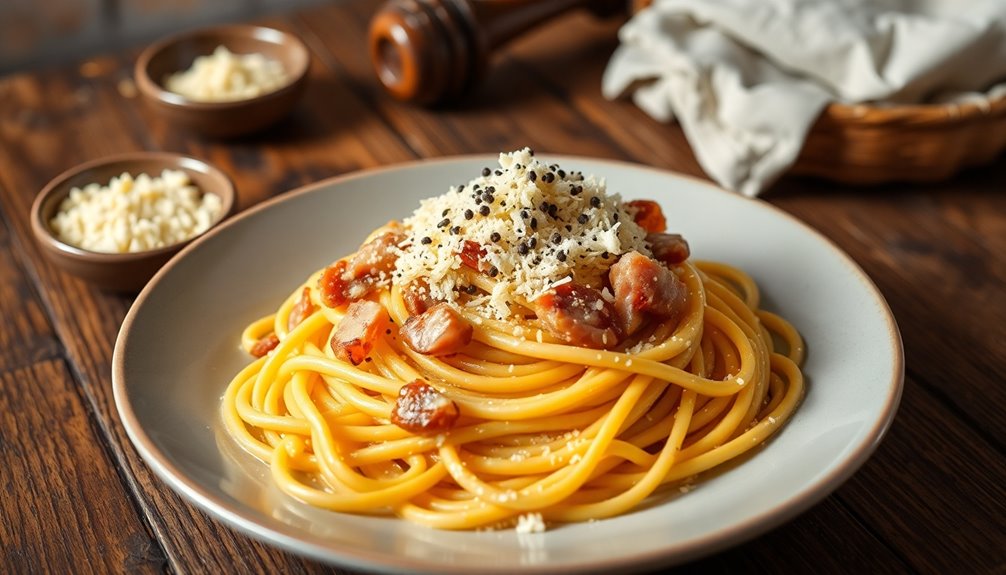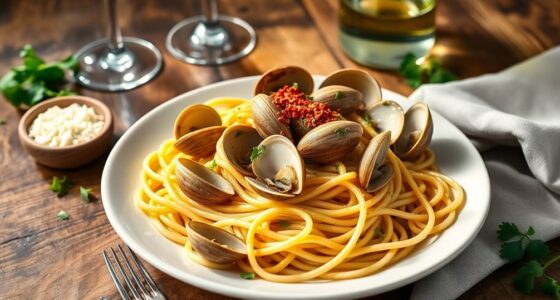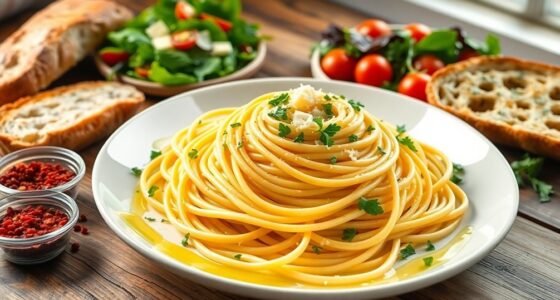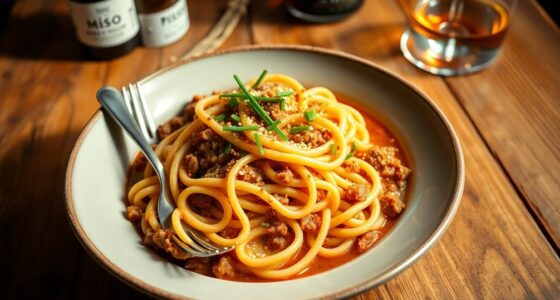To take your spaghetti carbonara to the next level, focus on high-quality ingredients like guanciale, egg yolks, and Pecorino Romano. Cook your pasta al dente and render the guanciale until it's crispy. Combine the hot pasta with the rendered fat, mixing in the egg yolks for that creamy sauce. Remember to balance flavors and add freshly cracked black pepper. Want to elevate your technique even further? Let's explore some additional tips and tricks.
History
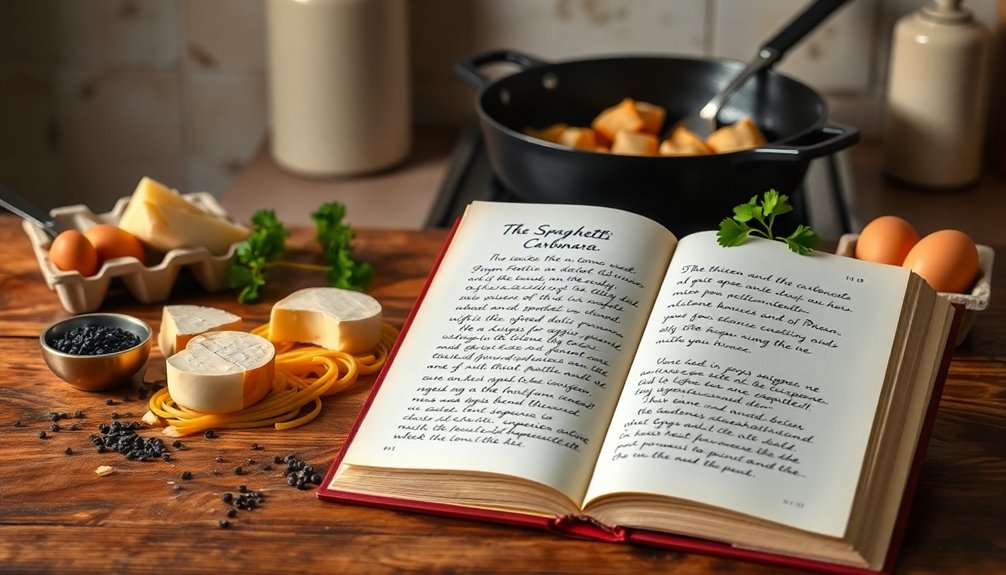
Spaghetti Carbonara, though its exact origins are debated, likely emerged in mid-20th century Rome, where it was created by Italian charcoal workers, known as "carbonari."
This connection to the charcoal burners gives the dish its name, as "carbonara" translates to "charcoal burner."
Traditional recipes highlight guanciale, a cured pork cheek essential for its unique flavor, while egg yolks provide a rich, creamy sauce without any cream.
As culinary historians explore its roots, they note that Carbonara has gained international popularity, inspiring countless adaptations.
While many variations incorporate cream, garlic, or vegetables, these diverge from authentic recipes.
Recipe
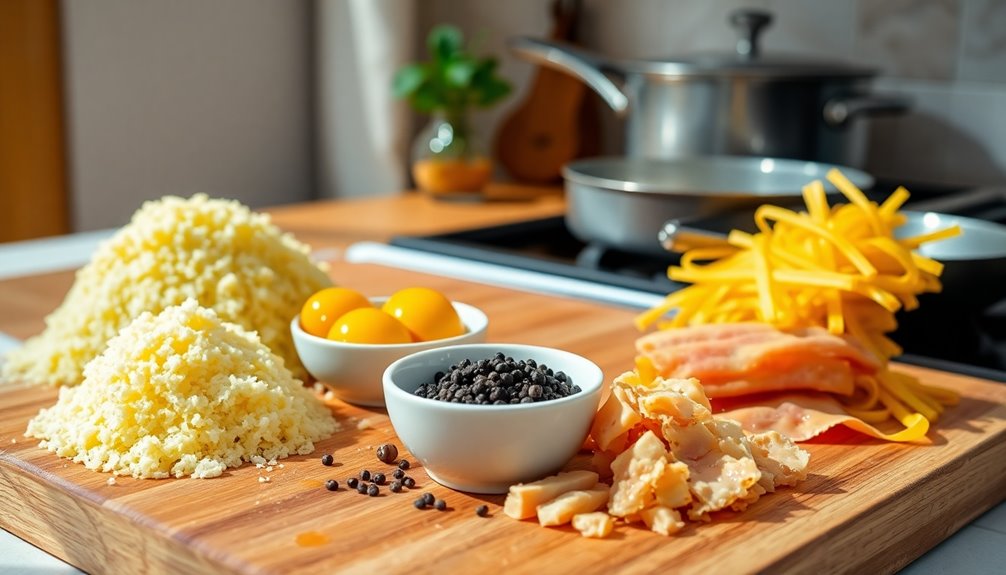
Ingredients:
- 400g spaghetti
- 150g guanciale or pancetta, diced
- 4 large egg yolks
- 100g Pecorino Romano cheese, grated
- Freshly cracked black pepper
- Salt (for pasta water)
Cooking Instructions:
Start by bringing a large pot of salted water to a boil and cook the spaghetti until al dente, according to package instructions.
While the pasta is cooking, heat a skillet over medium heat and add the diced guanciale or pancetta, cooking until it becomes crispy and golden.
Once the pasta is ready, reserve about 1 cup of the pasta water, then drain the spaghetti.
Immediately add the hot pasta to the skillet with the guanciale, removing it from the heat.
In a separate bowl, whisk together the egg yolks, grated Pecorino Romano cheese, and a generous amount of black pepper.
Quickly combine the egg mixture with the pasta, adding reserved pasta water as needed to achieve a creamy consistency while ensuring the egg yolks don't scramble. Quinoa is a complete protein, containing all nine essential amino acids, which can make for a great side dish if you want to balance out your meal.
Extra Tips:
For a more luxurious version of spaghetti carbonara, consider using duck or goose egg yolks, which provide an extra richness to the sauce.
Additionally, be sure to work quickly when mixing the pasta with the egg mixture to prevent the eggs from cooking too much and turning into scrambled eggs.
Finally, a sprinkle of additional Pecorino Romano and freshly cracked black pepper right before serving will enhance the flavors and presentation of this delightful dish.
Enjoy your carbonara immediately for the best texture and taste!
Cooking Steps
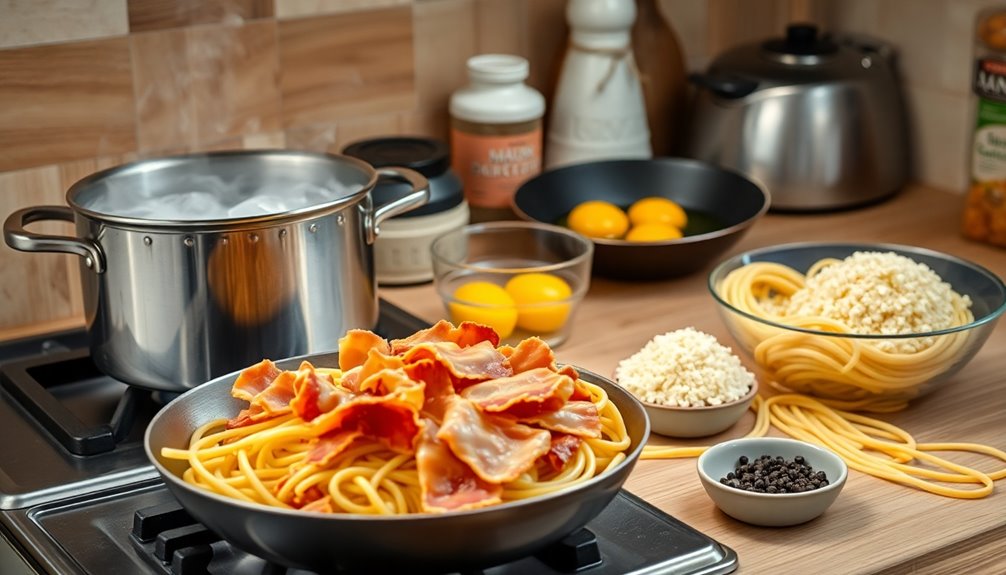
When you're ready to make your spaghetti carbonara, start by choosing high-quality guanciale for the best flavor.
Don't forget to add freshly cracked pepper to enhance the dish's richness.
Finally, whisk the eggs and cheese together to create a creamy sauce that you'll toss with the pasta right away.
Step 1. Choose High-Quality Guanciale
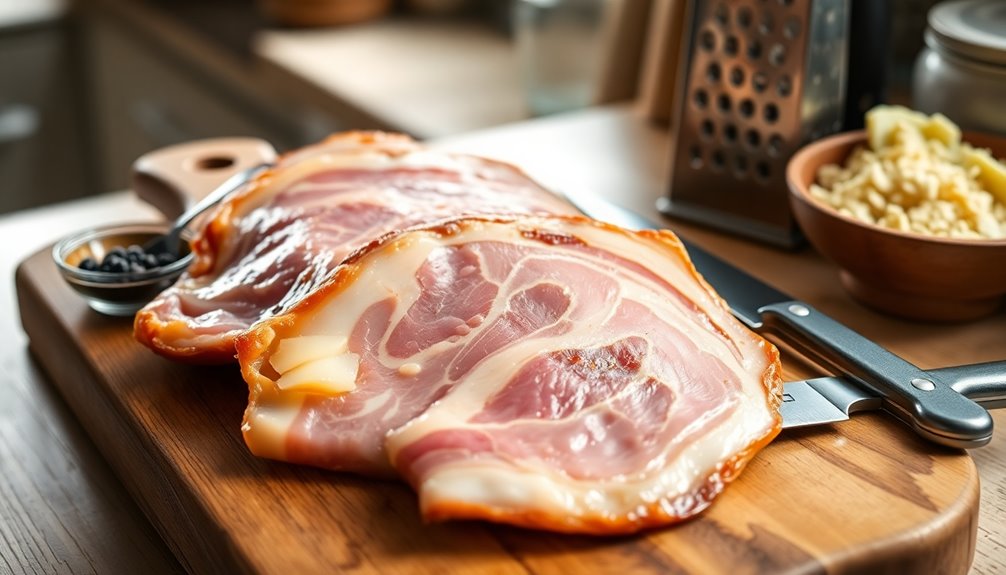
Choosing high-quality guanciale is essential for achieving an authentic spaghetti carbonara. This cured pork jowl delivers a rich, fatty flavor that surpasses the taste of traditional bacon or pancetta.
When you're selecting guanciale, look for a high-fat-to-meat ratio, which contributes to the creamy sauce consistency and depth of flavor in your dish. Authentic guanciale should have a well-seasoned crust and a buttery texture, enhancing the overall taste of your carbonara.
Always check for quality by sourcing guanciale from reputable producers, as the best options come from heritage breed pigs.
To prepare it for cooking, slice the guanciale into medium-thick cubes or strips, allowing it to crisp perfectly when rendered in the pan. Enjoy the richness!
Step 2. Add Freshly Cracked Pepper
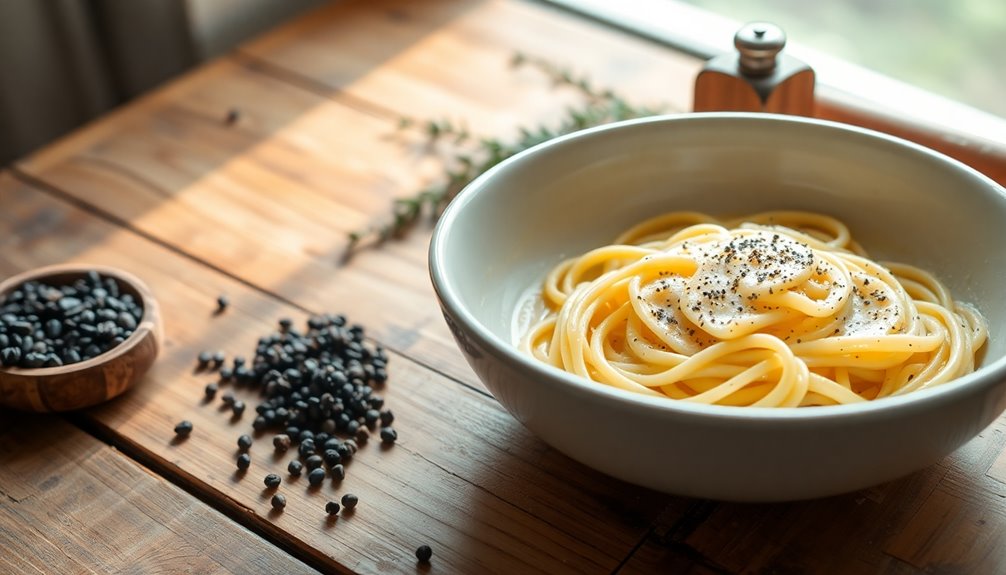
After you've prepared your guanciale, it's time to elevate your spaghetti carbonara with freshly cracked black pepper.
Start by toasting the black pepper in the hot fat rendered from the pancetta or guanciale. This step intensifies the flavor and adds an aromatic touch to your sauce.
Use a pepper mill to grind the pepper just before adding it, ensuring you capture that vibrant essence that pre-ground varieties often lack.
Generously sprinkle the freshly cracked pepper over the pasta during the final assembly. The traditional carbonara is known for its visible specks of black pepper, so don't shy away from adjusting the amount to suit your taste.
Aim for a balance that complements the richness of the sauce without overpowering it.
Step 3. Whisk Eggs and Cheese Together
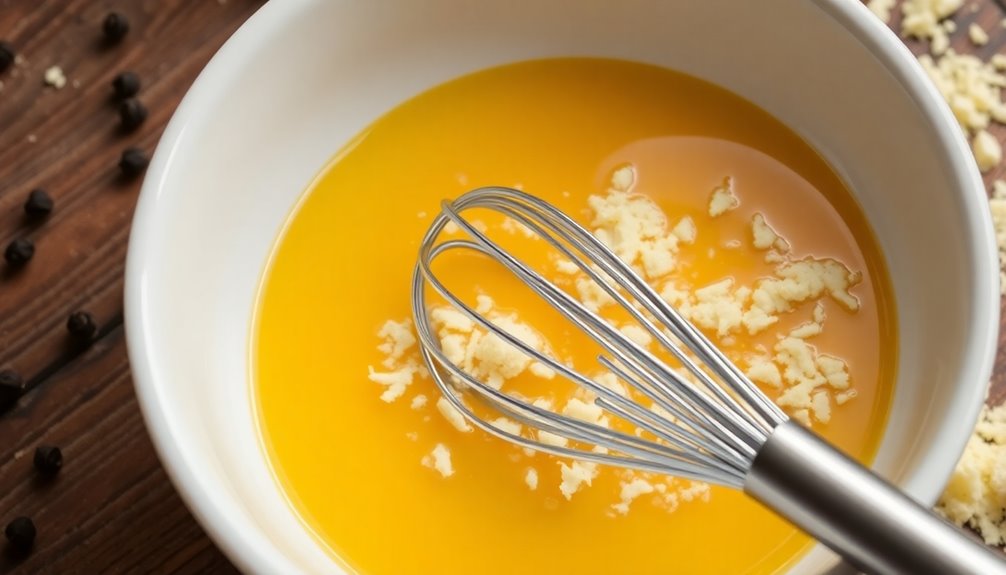
Start by whisking together 4 egg yolks and one whole egg in a mixing bowl until the mixture is smooth and creamy.
Gradually incorporate 100g (3.5oz) of freshly grated Pecorino cheese into the egg mixture. This adds a rich flavor and enhances the creaminess of your carbonara sauce.
Make sure to add a generous amount of cracked black pepper, as it's essential for achieving that characteristic carbonara flavor.
Avoid mixing the egg yolks with the cheese beforehand to prevent clumping; you want a silky sauce consistency.
Finally, remember to reserve some pasta water. This will help you adjust the sauce's consistency later, ensuring it's velvety and perfectly coats your pasta.
Enjoy the process!
Step 4. Toss Pasta With Sauce Immediately
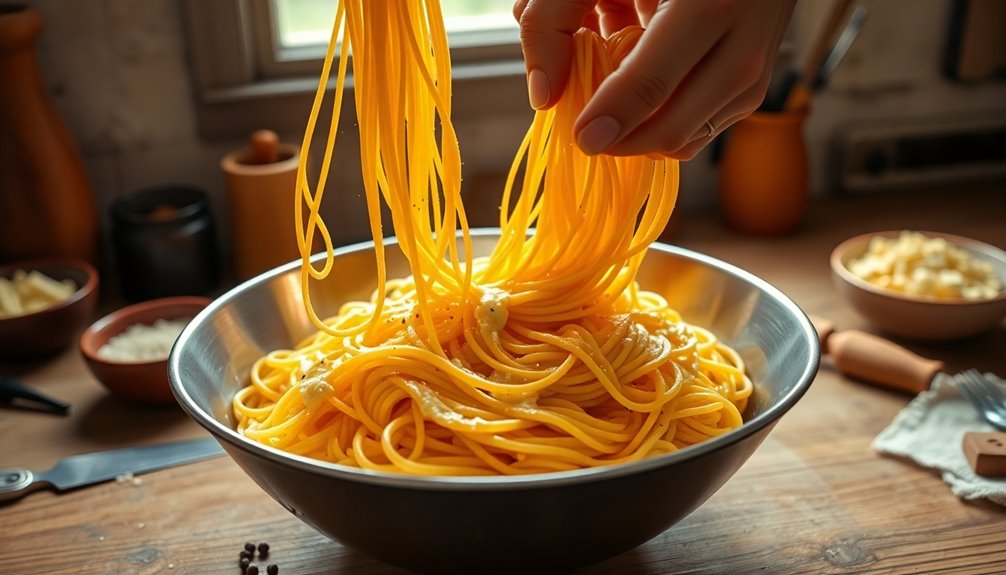
As you lift the cooked pasta from the boiling water with kitchen tongs, make sure to transfer it directly into the pan with the rendered pancetta.
Using a wooden spoon, stir the pasta into the fat thoroughly, adding some pasta water to keep it moist. Quickly incorporate the beaten egg yolks, stirring vigorously to avoid scrambling and to create that creamy sauce you crave.
If the mixture appears claggy, rinse the bowl containing the yolks with more pasta water and pour it in to adjust the consistency.
Finally, add the majority of the grated Parmesan cheese, mixing well. Don't forget to check the sauce's thickness; feel free to add more pasta water if necessary.
Enjoy your delicious creation!
Step 5. Add Reserved Pasta Water
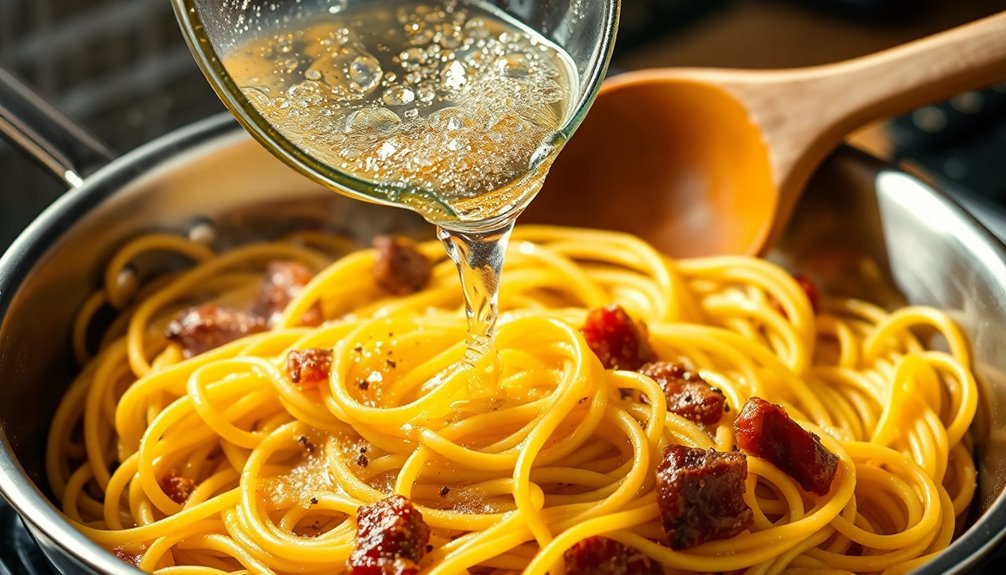
To achieve the perfect creamy texture in your spaghetti carbonara, it's essential to add reserved pasta water at the right moments.
Start by reserving a good amount of pasta water before draining your spaghetti. When you combine the pasta with pancetta, add a small ladleful of that reserved pasta water. This prevents the pan from drying out and helps emulsify your sauce.
After you beat the egg yolks, rinse your mixing bowl with more pasta water, then incorporate it into the dish to create a smooth sauce. If you notice the sauce is too thick, gradually add more reserved pasta water until it reaches the ideal consistency, similar to double cream.
Enjoy your velvety spaghetti carbonara!
Final Thoughts
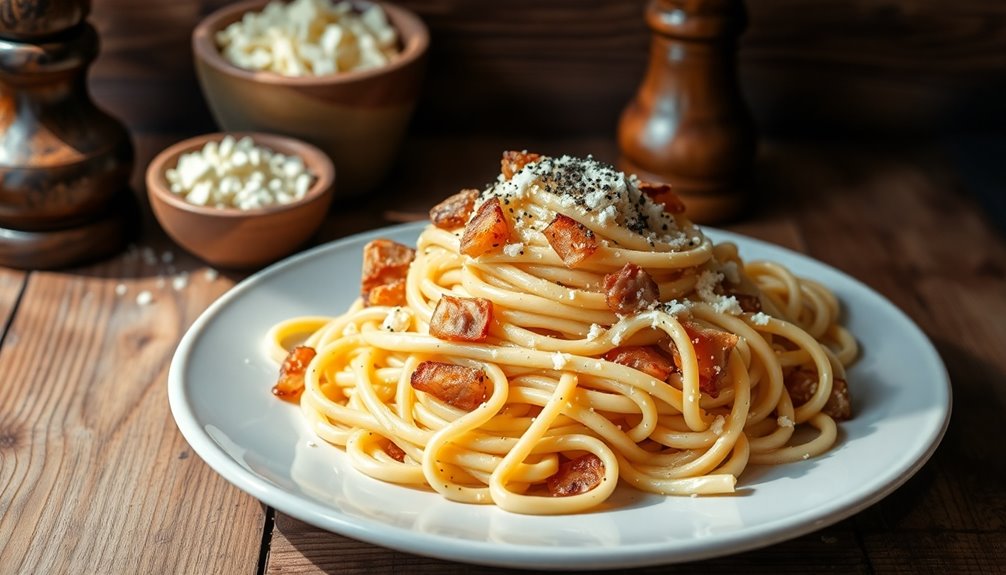
While mastering spaghetti carbonara may seem intimidating, the rewards are well worth the effort. By focusing on high-quality ingredients like guanciale instead of pancetta and freshly grated Pecorino cheese, you elevate your dish to next level spaghetti.
The secret to a creamy sauce lies in the careful emulsification of egg yolks with rendered pork fat, ensuring you manage the temperature to avoid scrambling. Remember, the residual heat from al dente pasta helps cook the egg yolks gently.
Don't forget the generous sprinkle of ground black pepper; it adds that signature kick. Finally, serve your carbonara immediately on warmed plates to maintain its rich flavors and creamy consistency.
Enjoy your culinary achievement!
Frequently Asked Questions
What Is the Golden Rule of Cooking Carbonara?
The golden rule of cooking carbonara is simple: rely exclusively on egg yolks and the residual heat from your pasta to create that silky sauce.
You'll want to avoid any direct heat, as it can lead to scrambling. Timing is key—add the pasta to the pancetta right after cooking.
What Is the Secret to the Best Carbonara?
The secret to the best carbonara lies in using high-quality ingredients.
You'll want to choose guanciale for its rich flavor, but pancetta works if guanciale's not available.
Freshly cracked black pepper adds essential heat, so toast it in hot fat for extra depth.
Only use egg yolks for that creamy texture, and remember to save some pasta water to adjust the sauce.
Serve immediately to keep everything perfectly silky and avoid clumping!
What Can You Add to Spaghetti Carbonara?
Imagine your carbonara as a canvas ready for vibrant colors and rich flavors.
You can add sautéed mushrooms for an earthy touch and sprinkle fresh parsley for a burst of freshness. A dash of lemon zest brightens the dish, while crushed red pepper flakes give it a spicy kick.
Tossing in peas or spinach adds sweetness and a pop of green, elevating both taste and nutrition.
Your carbonara will never be the same!
How Do You Take Spaghetti Sauce to the Next Level?
To take your spaghetti sauce to the next level, start by using high-quality ingredients like aged cheeses and flavorful cured meats.
Sauté aromatics like garlic and shallots in olive oil for a fragrant base.
Add fresh herbs for a burst of flavor and finish with a drizzle of high-quality olive oil or truffle oil.
For complexity, incorporate a splash of white wine or a spoonful of tomato paste to enhance the sauce's richness.
